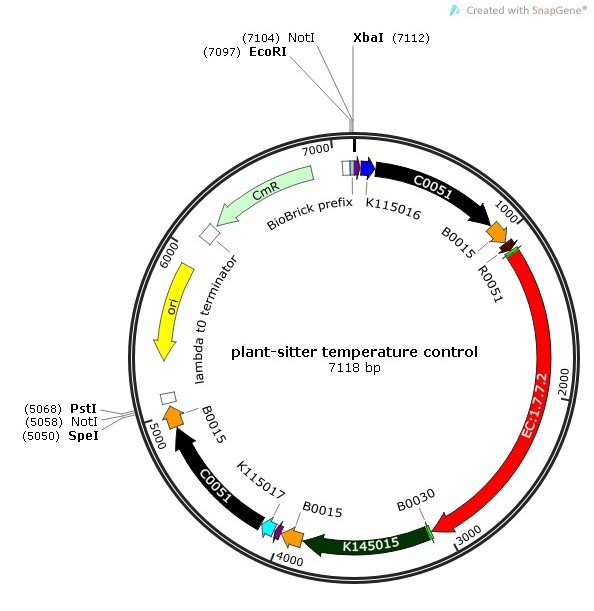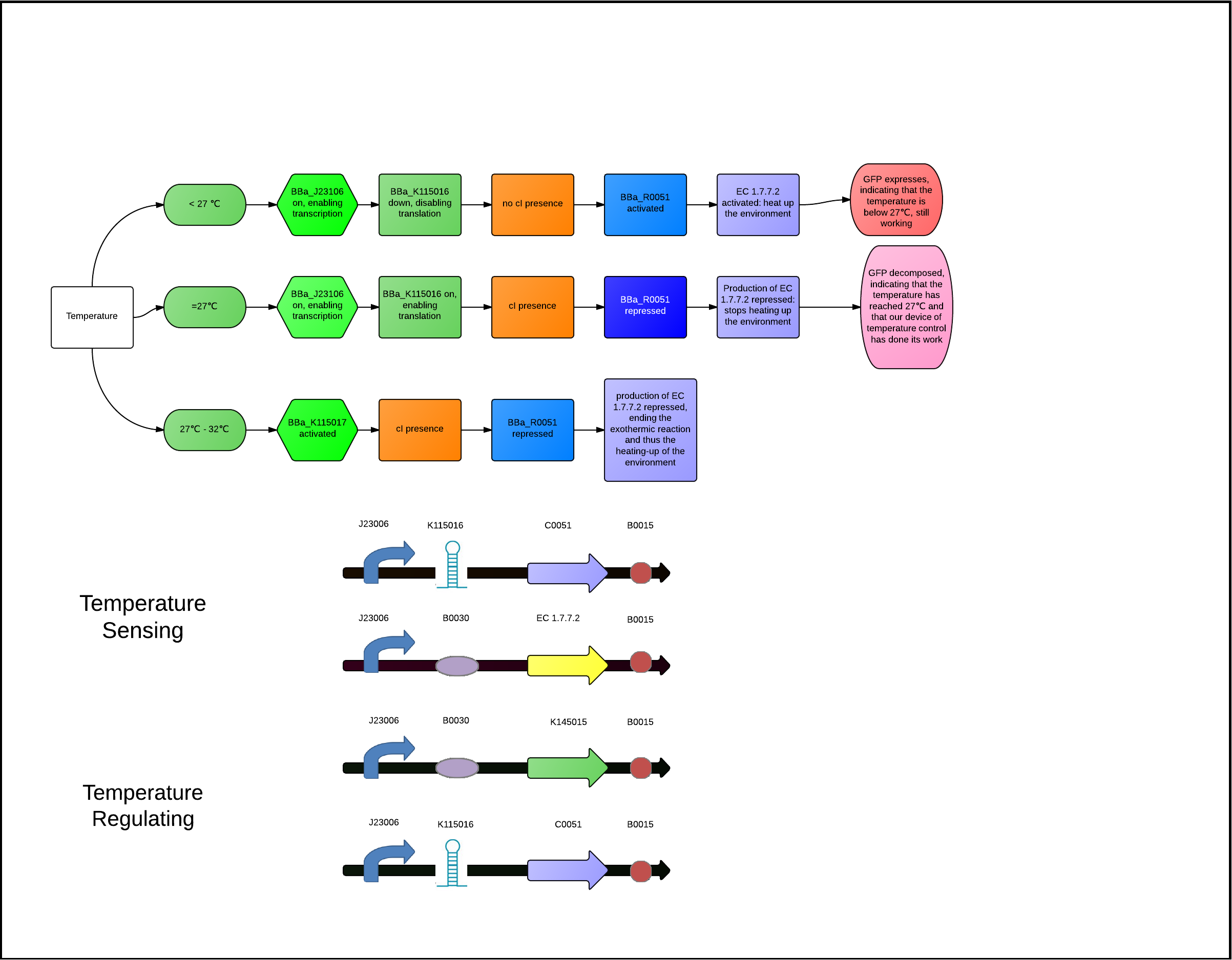Team:Shenzhen SZMS/Project
From 2014hs.igem.org
Our project is to create an “E. coli Plant-sitter” that achieves smart maintenance of healthy plant growth through the application of synthetic biology to temperature moderation. We hope that our toolkit will simplify the process of plant cultivation, enlarge the public understanding of synthetic biology, and make the methods and technology of synthetic biology accessible to people’s daily life.
Hothouse plants whose preferential temperature ranges from 25~30℃ are exposed to the threat of low productivity and unhealthy growth in overly cold environments. Therefore, we came up with a system that aids the healthy growth of these plants by protecting them from overly low temperatures through smart temperature control. Our system of temperature moderation includes two parts, temperature sensing and temperature regulating.
The process of temperature sensing involves a promoter, a 27℃ RNA thermometer, and cI. The process of temperature regulating involves a cI regulated promoter, an enzyme which catalyzes an exothermic chemical reaction, a 32℃ RNA thermometer, and a GFP LVA device which serves to indicate the occurrence of a change in temperature. The promoter in temperature sensing part is consistently on and thus so is the process of cI’s transcription from DNA to RNA. When the temperature is below 27℃, the 27℃RNA thermometer takes a curved, locked structure which does not enable translation from RNA to protein cI, which in turn allows the activation of the cI regulated promoter, the production of the enzyme, the occurrence of an exothermic reaction which heats up the environment, and the expression of GFP LVA tag which gives out green light to indicate that the temperature is below 27℃ and that our device of temperature control is doing its work. When the temperature rises and reaches 27 ℃ as a result of the exothermic reaction, the 27℃ RNA thermometer enables the translation of cI protein, which in turn represses the cI regulated promoter, ending the release of heat through the exothermic reaction by stopping the production of the enzyme which catalyzes that reaction. As a result of an inactive promoter (the cI regulated), the GFP also stops its expression and is decomposes, indicating that the temperature has risen from below 27 ℃ to 27 ℃and that our system of temperature control has done its work.
If the 27℃ RNA thermometer fails to stop the heating process at around 27℃ and the temperature keeps rising up to 32℃, the 32℃ RNA thermometer is activated, leading to the presence of protein cI, which places a double-check on the inhibition of the heating process.
Plasmid and Parts used
The parts we used are given below:
| Compile | Function | Introduction |
|---|---|---|
| J23106 | Promoter | It promotes the transcription of the following parts. |
| R0051 | CI regulated Promoter | It promotes the transcription without CI. When CI is binding to it,it is repressed. |
| K115016 | 27℃ RBS | It only promotes the translation when the temperature is over 27℃ |
| K115017 | 32℃ RBS | It only promotes the translation when the temperature is over 32℃ |
| B0030 | strong RBS | It can promotes the translation strongly. |
| C0051 | Coding sequence | It is the coding sequence of CI Protein. |
| 1.7.7.2 (KEGG) | Coding sequence | We got this part from bacillus subtilis best7613 strain.It catalyzes the reaction which converts Nitrate to Nitrite. |
| K145015 | Coding scquence | It is the coding sequence of GFP. |
| B0015 | Terminator | It can stop the transcription. |
Temperature Sensing
This process involves BBa_J23106 (promoter), BBa_K115016 (27℃ RNA thermometer), and cI (Repressor protein cI). BBa_J23106 is consistently on and thus so is the process of cI’s transcription from DNA to RNA. When the temperature is below 27℃, the 27℃ sensitive RNA thermometer does not enable translation from RNA to protein cI, which in turn allows the activation of BBa_R0051, the production of the enzyme, the occurrence of an exothermic reaction which heats up the environment, and the expression of GFP LVA tag which gives out green light to indicate that the temperature is below 27℃ and that our device of temperature control is doing its work. When the temperature rises and reaches 27 ℃ as a result of the exothermic reaction, BBa_K115016 (27℃ RNA thermometer) enables the translation of cI protein, which in turn represses BBa_R0051, ending the release of heat through the exothermic reaction by stopping the production of the enzyme which catalyzes that reaction.
As a result of an inactive promoter (BBa_R0051), the GFP also stops its expression and is decomposes,
indicating that the temperature has risen from below 27 ℃ to 27 ℃and that our system of temperature control has done its work.
If BBa_K115016 (27℃ RNA thermometer) fails to stop the heating process at around 27℃ and the temperature keeps rising up to 32℃, BBa_K115017 (32℃ RNA thermometer) is activated, leading to the presence of protein cI,
which places a double-check on the inhibition of the heating process.
The process by which our temperature-control system operates may be better illustrated in the following flow chart:
Temperature Regulating
The process of temperature regulating involves BBa_J45503 (cI regulated promoter), an enzyme which catalyzes an exothermic chemical reaction, BBa_K115017 (32℃ RNA thermometer) and a GFP LVA device which serves to indicate the occurrence of a change in temperature.
 "
"

